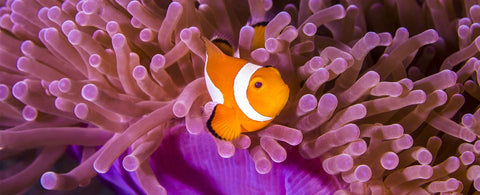Valentine’s Day is all about celebrating love!
Just like humans, animals often form relationships based on love and spending koala-ty time together. These are called Symbiotic relationships and some of them are especially close where each pair has mastered the concept of mutual give and take in the relationship. Essentially, the perfect life partners.
Let’s take a look at five of these perfect pairs:
Clownfish & anemones

Anemones are a close relative of coral and jellyfish that have long tentacles and spend most of their time attached to rocks or coral reefs. Their tentacles are filled with neurotoxin that sting their prey for protection. There is one species of fish that are immune to the anemone sting, the clownfish ( aka Nemo).
This allows clownfish to use anemone’s tentacles as a shelter to hide from their predators. In return for protection, clownfish help out the anemones by keeping them free of parasites, occasionally dropping food and driving off intruders. Anemones that home clownfish appear to grow faster, have higher rates of asexual reproduction and lower mortality than those without.
Woolly bats & pitcher plants

The pitcher plant is a carnivorous plant found in Western Australia named so because of their hollow pitcher form. They use nectar at the rim of their tube-like form to lure in their prey. The slippery nectar causes small insects and vertebrates to fall into the digestive juices inside the plant – delicious... Unlike other small critters, woolly bats are drawn to the plants because they make the perfect hiding spot to rest in. While the woolly bat gets to hide out in the pitcher plant, the plant benefits from the nutrients provided by the feces of the small mammals.
Is romance dead? Not according to this pair, that’s for sure.
Sharks & fish friends

Sharks mostly prefer to live their lives alone, but they have been known to befriend a fish here and there. Remora and pilot fish can often be seen swimming alongside sharks. They eat any leftovers the shark leaves behind as well as parasites on the shark’s skin and mouth - yum. These pesky parasites would otherwise irritate and or harm the shark. In return, sharks provide protection for the fish from larger predators and give some of them a ride across the ocean. Observations have led us to believe that sharks can somewhat understand the benefits of having other fish around and have been seen swimming slower to allow fish to suction to them or catch up.
Oxpeckers & large mammals
Oxpeckers spend a lot of their time hanging out on the back of large grazing mammals like zebras, wildebeests and rhinos. The birds eat parasites, ticks and flies off these mammals . This helps to keep the parasites off of the mammals and also provides a meal for the birds. Oxpeckers have also been seen making noise to alert the mammals of potential threats or dangerous predators. Just like any relationship, there are challenges - Oxpeckers, for example, can dig into wounds on the mammals and although they seem to tolerate it, it's not particularly beneficial to them.
Senita cactuses & senita moths
Senita cactuses are native to southern Arizona in the United States and northwestern Mexico. These cactuses bloom pale pink flowers that open during the night and close once the sun starts to rise. The senita cactus has an especially strong bond with senita moths, which are responsible for 75-95% of its pollination. Female senita moths collect pollen on their unique abdominal scales and transfer it from flower to flower. During pollination, the moth will lay an egg on the flowers and once they close, the larva hatches. The new moth will then spend days feeding on the newly emerged fruit and seeds. But don’t worry, the moths leave *just* enough seeds and fruit for the cactus to continue to grow.
And there you have it, proof that there’s a whole lot of L.O.V.E in the animal kingdom air!
Happy Valentine’s Day, today and everyday ❤️
Sources:
- nationalgeographic.org | Symbiosis: The Art of Living Together
- nhm.ac.uk | Mutualism: eight examples of species that work together to get ahead
- discovery.com | Sharks and their Interspecies Friendships


